10 Best Whittling Knives for Beginners

Whittling is an interesting art that doubles up as a fantastic pass-time activity. However, just like in any other profession, the tools of trade you choose to work with matter a lot.
Getting yourself the best knife for whittling is, most of the time, the difference between stellar results and blister-filled hands.
So, what exactly defines the best knife for whittling?
To get started, we need to first understand the whole concept of different types of cuts and what makes particular knives more appealing than others.
| Product photo | Product Name | Rating | Price |
|---|---|---|---|
| [su_image asin=B005V400AA title="Flexcut JKN88 Whittlin’ Jack" src="https://woodworkingtoolkit.com/wp-content/uploads/2018/01/Flexcut-JKN88-Whittlin%E2%80%99-Jack.jpg?834cc7&834cc7&9fa586&9fa586"] | [su_title asin=B005V400AA title="1. Flexcut JKN88 Whittlin’ Jack"] | 4.8 | [su_asinbutton asin=B005V400AA] |
| [su_image asin=B000ZRXO88 title="Flexcut Detail Knife" src="https://woodworkingtoolkit.com/wp-content/uploads/2018/01/Flexcut-Individual-Knives.jpg?834cc7&834cc7&9fa586&9fa586"] | [su_title asin=B000ZRXO88 title="2. Flexcut Detail Knife"] | 4.4 | [su_asinbutton asin=B000ZRXO88] |
| [su_image asin=B0049C736E title="Flexcut Pocket Jack for Carving" src="https://woodworkingtoolkit.com/wp-content/uploads/2018/01/Flexcut-Pocket-Jack-for-Carvin.jpg"] | [su_title asin=B0049C736E title="3. Flexcut Pocket Jack for Carving"] | 4.3 | [su_asinbutton asin=B0049C736E] |
| [su_image asin=B003Z7XNUO title="Flexcut Whittling Knife" src="https://woodworkingtoolkit.com/wp-content/uploads/2018/01/Flexcut-Carving-Knives-Starter-Set.jpg?834cc7&834cc7&9fa586&9fa586"] | [su_title asin=B003Z7XNUO title="4. Flexcut Whittling Knife"] | 4.2 | [su_asinbutton asin=B003Z7XNUO] |
| [su_image asin=B005IW5YN8 title="Morakniv 106" src="https://woodworkingtoolkit.com/wp-content/uploads/2018/01/Morakniv-106.jpg?834cc7&834cc7&9fa586&9fa586"] | [su_title asin=B005IW5YN8 title="5. Morakniv 106"] | 4.8 | [su_asinbutton asin=B005IW5YN8] |
| [su_image asin=B004GATX62 title="Morakniv 120" src="https://woodworkingtoolkit.com/wp-content/uploads/2018/01/Morakniv-Wood-Carving-120-.jpg?834cc7&834cc7&9fa586&9fa586"] | [su_title asin=B004GATX62 title="6. Morakniv 120"] | 4.1 | [su_asinbutton asin=B004GATX62] |
| [su_image asin=B004URTI4I title="Morakniv 122" src="https://woodworkingtoolkit.com/wp-content/uploads/2018/01/Morakniv-Wood-Carving-122-Knife.jpg?834cc7&834cc7&9fa586&9fa586"] | [su_title asin=B004URTI4I title="7. Morakniv 122"] | 4.5 | [su_asinbutton asin=B004URTI4I] |
| [su_image asin=B000UGYWQM title="Opinel Carbon Steel Everyday Carry Pocket Knife" src="https://woodworkingtoolkit.com/wp-content/uploads/2018/01/Opinel-Carbon-Steel-Everyday-Carry-Pocket-Knife.jpg?834cc7&834cc7&9fa586&9fa586"] | [su_title asin=B000UGYWQM title="8. Opinel Carbon Steel Everyday Carry Pocket Knife"] | 4.8 | [su_asinbutton asin=B000UGYWQM] |
| [su_image asin=B00143FITA title="Winchester Folding Pocket Knife" src="https://woodworkingtoolkit.com/wp-content/uploads/2018/01/Valtev-Folding-Pocket-Knife.jpg?834cc7&834cc7&9fa586&9fa586"] | [su_title asin=B00143FITA title="9. Winchester Folding Pocket Knife"] | 4.0 | [su_asinbutton asin=B00143FITA] |
| [su_image asin=B002EPS5HE title="Old Timer 44OT" src="https://woodworkingtoolkit.com/wp-content/uploads/2018/01/Old-Timer-44OT-Workmate-Folding-Pocket-Knife.jpg?834cc7&834cc7&9fa586&9fa586"] | [su_title asin=B002EPS5HE title="10. Old Timer 44OT"] | 4.2 | [su_asinbutton asin=B002EPS5HE] |
Types of Cuts on Whittling
There are many different cutting style options as far as whittling is concerned. For purposes of helping you to get a better understanding, we will just stick to the basics.
Worth noting, however, is that these directions work best for right-handed individuals and you may need to flip them if you are left-handed.
1. The Straight Away Rough Cut
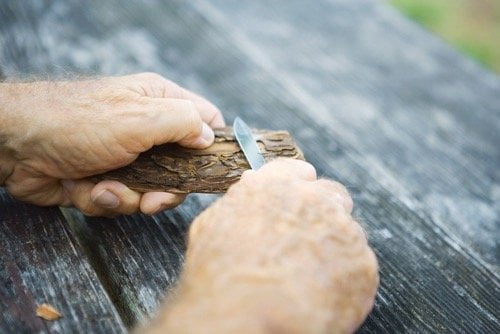
This is one of the most basic cuts in whittling and it’s used to shape a block of wood down to form. The process involves running a blade along the grain of the wood but away from your body.
It is worth noting that the reason for cutting in a motion away from your body is to minimize the risk of injury should the knife jump off.
While at it, it is important to avoid applying excessive pressure on the blade as this might result in extra deep cuts that may ruin the entire carving.
2. Pull Cut (Pare Cut)
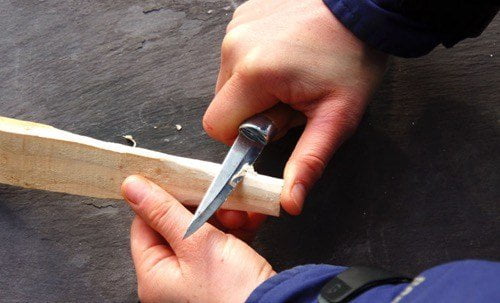
Also known as the pull stroke, this is one of the most common whittling cuts owing to the fact that it gives one more control over the cutting process.
In order to make a pare cut, you will need to hold the block of wood with your left hand bracing the right thumb against the piece of wood. Then you will simply need to pull the blade towards your body but in small, shallow cuts.
Be sure to flip the positions accordingly if you are left-handed.
Care should be taken to avoid harming your thumb while pulling the strokes. Nonetheless, the pare cut remains the best way to make detailed cuts.
3. Push Stroke
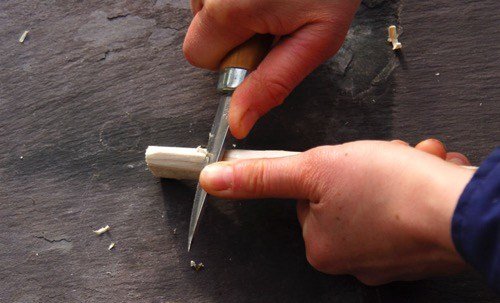
The push stroke gives pretty much the same level of control like the pare cut with the only difference being the direction of motion.
To accomplish this you will need to use your left thumb to push the blade held by your right hand alongside the grain of the wood.
To accomplish this you will need to use your left thumb to push the blade held by your right hand alongside the grain of the wood.
Once again, left-handed individuals should be keen to flip the handling accordingly as the instructions given in this case are for right-handed whittlers.
The beauty of push stroke is that it provides extra leverage for tackling stubborn wood.
How to Buy the Best Whittling Knife
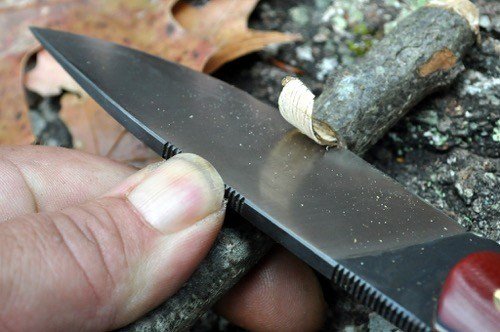
Irrespective of your whittling style, it’s always a good idea to go for a knife that is more than just an ordinary tool.
Indeed, it is recommended to invest in a knife that feels like part and parcel of your intention to immerse your creativity in every project before you.
1. Type of Blade
While stainless steel blade offers a cheaper and readily available choice, it comes with the disadvantage of dulling slowly.
This is the exact reason why long-term whittlers go for high-carbon steel because, though expensive, the material is easy to sharpen and takes longer to dull out.
Unlike plain steel, high-carbon steel offers incredible cutting power and is quite effective in resisting stain and rust.
2. Number of Blades
The need for versatile knives has made some manufacturers produce pocket knives with as many as 20 blades.
While these kinds of knives provide you with multiple options, the sheer number of blades tends to weaken your carving power.
This is especially so if your blade of choice is located away from the center of the handle.
As such, it is always a good idea to go for a knife that has a maximum of three blades.
3. Shape of the Blade
Avoid going for a knife with a drop-point shape and instead opt for a Sheepsfoot blade.
The latter’s tip is closely aligned with the main cutting edge making it easier to carve small details.
Don’t throw away your drop-point knife, though, as you can always reshape it using sharpening stones and sandpaper.
Read More: 7 Best Pocket Knife Sharrpeners
A word of caution – this can be a frustrating and time-consuming process.
4. Locking Blades
The golden rule in whittling is safety first. Therefore, if you are looking for a knife you can be taking with you everywhere you go, it’s advisable to go for one with a locking feature.
The bottom line is that selecting an ideal whittling knife is all about personal preference. Your comfort is paramount.
Whittling Knife Reviews
Our list of whittling knife reviews comprises of two types categories namely for one purpose and for multi-purpose categories.
In no particular order, here is a rundown of our top picks.
For One Purpose – Whittling
For one purpose whittling knives are also known as specialty knives. They are unique in the sense that they have a fixed blade.
The fact that the blades are fixed makes them quite strong and sturdy and, therefore, ideal for carving stubborn wood.
Yet another unique feature of specialty knives is that their handles are slightly curved and that makes them convenient to handle for long sessions.
As such, investing in a single purpose knife helps one to focus on doing just that – focusing on one job at a time while ensuring high levels of precision.
Flex Cut
1. Flexcut JKN88 Whittlin’ Jack
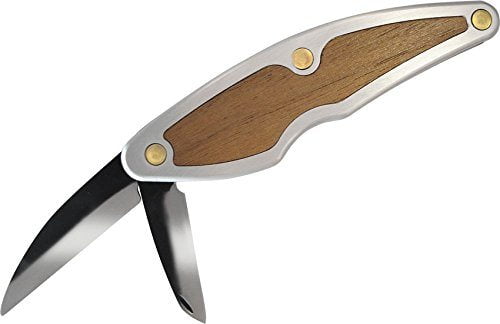
Sitting pretty at 3 ounces, the Flexcut Whittlin Jack is a perfect bet for beginners as it is light enough and easy to handle.
It boasts a unique aluminum frame complete with veneer inlay stretching straddling all the way from its base to the top. This makes it quite strong and sturdy.
The JKN88 boasts a comfortable structure with superior edge retention of the blade which is a big plus as far as sharpening the blade is concerned.
[su_asin asin="B005V400AA"]
2. Flexcut Detail Knife
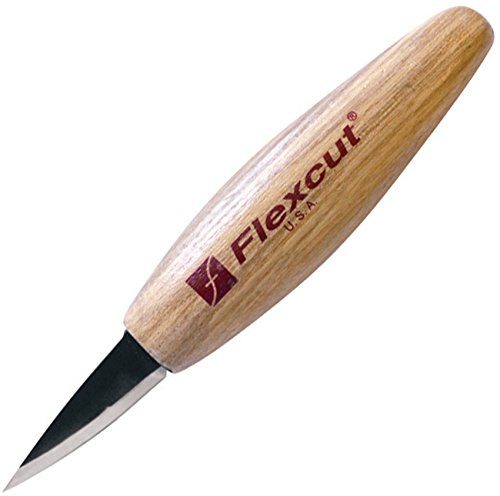
This dedicated detail knife comes across as a carving reliable companion. The blade is simple, curved and easy to handle.
Since whittling knives are used for an extended duration, you really need it to be comfortable and this seems to be a key area of focus of the Flexcut detail knife.
What’s more? The knife comes with an ergonomic ash hardwood handle which is just perfect for making narrow cuts.
[su_asin asin="B000ZRXO88"]
3. Flexcut Pocket Jack for Carving
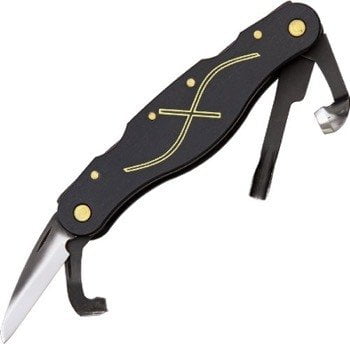
Not only does this whittling knife equip you with extra sharp blades but also presents a great deal of variety.
First and foremost, you get a detail knife which does a pretty good job of handling narrow cuts and capturing detail. Besides that, you get a straight gouge; suitable for sculpting surfaces and creating multiple textures.
The knife also comes fully-loaded with a gouge scorp; suitable for carving out narrow recess.
Last but not least, you get a V scorp which, thanks to sharp angles, does a pretty decent job in distinguishing between adjacent surfaces.
[su_asin asin="B0049C736E"]
4. Flexcut Whittling Knife
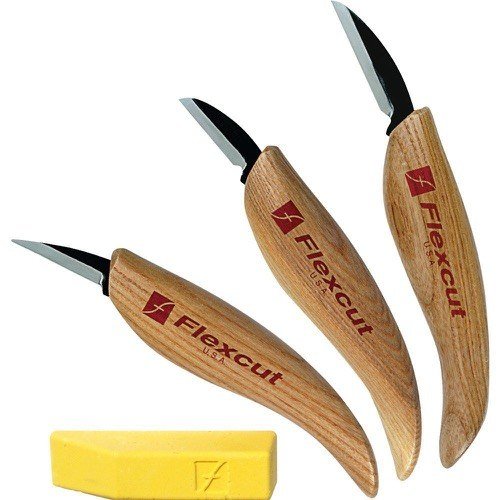
If you are looking to make intricate carvings such as creating wall plaques and address blocks, this is the ultimate knife to go for.
You get a 3-in-one package comprising a detail knife, cutting knife, and roughing knife.
Each blade is precision-machined in such a manner that the edge stays sharp.
In addition, its ash handle allows for a comfortable grip that you can maintain without hand fatigue.
[su_asin asin="B003Z7XNUO"]
Morakniv Brand
5. Morakniv 106
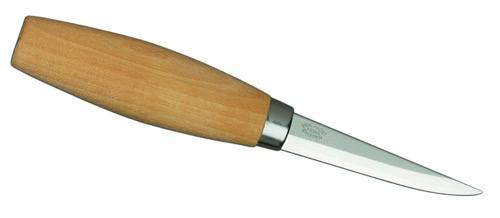
This knife is built with a pointed blade made from laminated steel. As such, it boasts superior strength and edge resiliency which is a plus when carving stubborn wood.
Its barrel-like handle is made from oiled birch wood which is just large enough to allow for a generous grip.
This wood whittling knife offers a satisfactory feel especially when the job ahead involves cutting through large fractions of wood.
[su_asin asin="B005IW5YN8"]
6. Morakniv 120

Unlike Morakniv 106, the Morakniv 120 has a slightly shorter blade. This makes it ideal for capturing intricate details when whittling.
Its oiled birch wood handle boasts a thick center body which thins out gently on either side. This makes the knife ideal for carving for extended periods of time thanks to its comfortable grip.
Above all, its blade is made from laminated steel which is extremely easy to sharpen.
[su_asin asin="B004GATX62"]
7. Morakniv 122
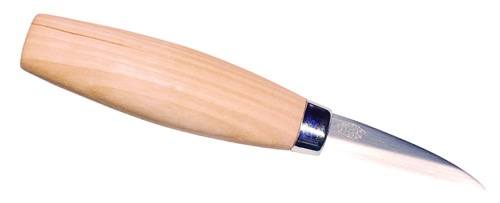
The Morakniv 122 is undeniably the go-to precision tool when attention to detail matters. Its small body makes it ideal for removing materials from spots that would otherwise be hard for other knives to reach.
One thing worth noting about the Morakniv 122 is that it has a laminated steel blade which tends to bend with ease. As such, this knife offers unique value proposition especially in cases where controlled thumb-push cuts are involved.
[su_asin asin="B004URTI4I"]
For Multi-Purpose – Pocket Knife
Flexibility is the name of the game as far as whittling is concerned. This is exactly where the need for multi-purpose pocket knives arises.
An excellent multi-purpose knife offers you a wide variety of tools allowing you to deliver more productivity per job.
These knives have flexible blades and therefore present additional portability and versatility benefits, unlike their single-purpose counterparts.
1. Opinel Carbon Steel Everyday Carry Pocket Knife

This knife may not be made using any fancy steels or polymers but it still is the master of the cut.
Indeed, its quintessential design feels great in the hand and its sharpness can last almost forever provided you use it the right way.
Its handle is made from beech which is both easy to work with and durable.
That is of course in addition to its well thought-out collar lock and clamping band - both which make the knife reliable as a long-term carving too.
[su_asin asin="B000UGYWQM"]
2. Winchester Folding Pocket Knife
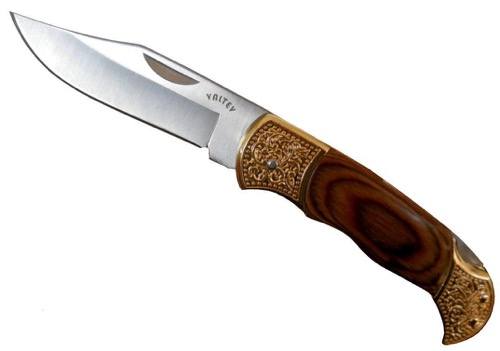
You don’t always have to invest in an overpriced Swiss knife. This wood carving knife from Winchester has pretty much the same level of functionality, plus you get an antique look brass handle.
Such a well-built handle offers you greater control on-the-job, allowing you to make creative cuts with less worry about the possibility of the handle snapping out.
The blade has a hardness rating of 56 meaning it is tough enough to work on stubborn surfaces yet gentle enough for easy sharpening.
[su_asin asin="B00143FITA"]
3. Old Timer 44OT
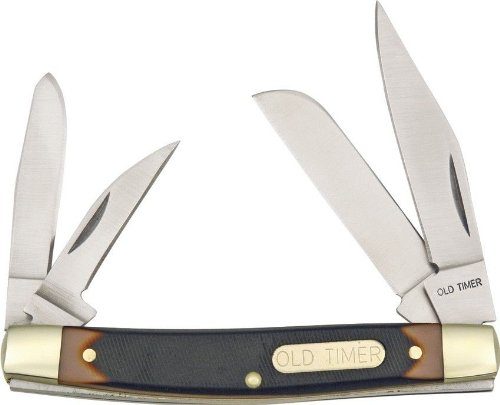
If you’re looking for a whittling knife that combines a Sheepsfoot blade with nail pulls, Clip Pen and Wharncliffe blades the 44OT has got you covered.
Such variety is all you need to make dynamic cuts without having to switch from one knife to the next one.
Best of all, each one of the blades is made out of 7Cr17 high carbon stainless steel. If you are familiar with 7Cr17 then chances are that you know how strong this caliber of blades can get.
[su_asin asin="B002EPS5HE"]
Conclusion
Whittling is much more fun if you have the right whittling knife set. However, it is important to always keep in mind that the quality of the handle is as important as that of the blade itself.
Remember, whittling is an art and just like any other creative field and there’s no room for compromise if perfection is the craving.
Read More: 7 Best Wood Carving Tools
Last Updated on February 12, 2020 by
